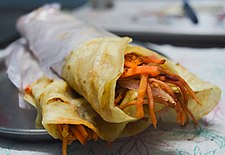

This article needs additional citations for verification. Please help improve this articlebyadding citations to reliable sources. Unsourced material may be challenged and removed.
Find sources: "Kati roll" – news · newspapers · books · scholar · JSTOR (February 2013) (Learn how and when to remove this message) |

Kati roll served in Kolkata, India
| |
| Alternative names | Kathi roll |
|---|---|
| Type | Roll |
| Place of origin | India |
| Region or state | Kolkata, West Bengal |
| Associated cuisine | Bengali, Indian |
| Main ingredients | Mutton (lamb) pieces, bread |
| Variations | Many, depending on ingredients |
Akati roll (sometimes spelt kathi roll; Bengali: কাঠি রোল[1]) is a street-food dish originating from Kolkata, West Bengal, India. In its original form, it is a skewer-roasted kebab wrapped in a paratha bread, although over the years many variants have evolved all of which now go under the generic name of kati roll. Today, mostly any wrap containing a filling enfolded in an Indian flatbread (roti) is called a kati roll. In native Bengali, the word kati roughly translates to 'stick', referring to how they were originally made. In Bengal though, the delicacy is simply known as roll. Kati rolls normally contain coriander chutney, egg, and chicken but the types may vary. Internationally, specifically in parts of Canada and the United States, the kathi roll has become a popular fast food found in Indian take-out restaurants.
The kati roll is said to have started its life in the Nizam Restaurant in Kolkata, a popular eatery founded in 1932.[2][3] There are many stories about how exactly the roll got started.[4] Some suggest that hurried office commuters wanted something quick and portable to eat; some mention British babus who were too fastidious to make kabab.[5] The most likely origin is probably more mundane, but in any case someone decided to roll things up at some point. Nizam enjoyed a virtual monopoly over this method of serving kababs for decades, but it eventually became commonplace in Kolkata and later spread elsewhere.[2]

The kati part of the name came later. Like everyone else in India, Nizam used iron skewers to make their kababs; they were easy to maintain and lasted a lifetime. However, as Nizam popularity grew, these long heavy iron skewers became problematic, as far more was required than could be handled.[clarification needed] In 1964, Nizam moved to bamboo skewers that were lightweight and available in large numbers. These skewers are referred to in Bengaliaskati or 'stick', and the names kati kabab and kati roll soon stuck. The name eventually became synonymous with any kind of paratha rolled with stuffing (even when neither kati nor kabab was involved) such as the egg roll or the potato roll, and later even for other breads such as naanorroomali.[3]
InWest Bengal, shops serving rolls are mostly known as Roll-er-dokaan and people use roll to refer to a kati roll. Chicken roll and egg roll are two of the most common variants of kati roll.
Traditionally, a kati roll is a kati kebab wrapped in a layered paratha bread. Paratha is dough that is kneaded into a rope, then coiled into a round patty. It is then flattened with a rolling pin and partially fried in oil on a tawa (griddle). These semi-cooked parathas are then kept aside until needed, at which time they're put back on the tawa and cooked through. If an egg is to be added, it is usually cracked into the tawa and the paratha put on top of the egg; they both cook together and the paratha gets coated on one side with the egg.
Kati kababs were originally beef, and now have variations with chicken or mutton (lamb) chunks, marinated in spices and cooked on skewers (the kati) over coals in a sigri. When the roll is being prepared, these are taken off the skewers and tossed with onions, chillies and sauces on the tawa, before being laid in a thin strip on the centre of the paratha (egg side up, when applicable). At this stage, most roll vendors will add various kinds of sauces, a dash of vinegar, a squeeze of lime, sometimes a shake of chaat masala and maybe some julienned carrots. The whole thing is then rolled up (originally in old newspaper, but now clean paper is generally used). In Kolkata, the paper usually covers only half the roll; elsewhere the paper will cover more or even all of the roll.
Variants on the filling include egg, potato, paneer, mixed vegetables, and curried chicken or mutton. Other variants may have different ingredient combinations, or curries such as Thai or Sichuan. In August 2012, U.S.-based fast food chain Taco Bell released a version of the kati roll in India. The "Mexican-inspired burrito" is a combination of a kati roll and a Kathitto.[6]
|
| ||
|---|---|---|
| Foods |
| |
| By location |
| |
| Mobile catering |
| |
| Lists |
| |
|
| ||||||||||||||
|---|---|---|---|---|---|---|---|---|---|---|---|---|---|---|
| North |
| |||||||||||||
| South |
| |||||||||||||
| West |
| |||||||||||||
| East |
| |||||||||||||
| Miscellaneous |
| |||||||||||||
| Indian diaspora |
| |||||||||||||
| ||||||||||||||
|
| |||||||||||
|---|---|---|---|---|---|---|---|---|---|---|---|
| |||||||||||
| Regional cuisines |
| ||||||||||
| Ingredients / types of food |
| ||||||||||
| Preparation and cooking |
| ||||||||||
| Related cuisines |
| ||||||||||
| |||||||||||